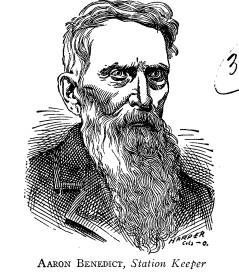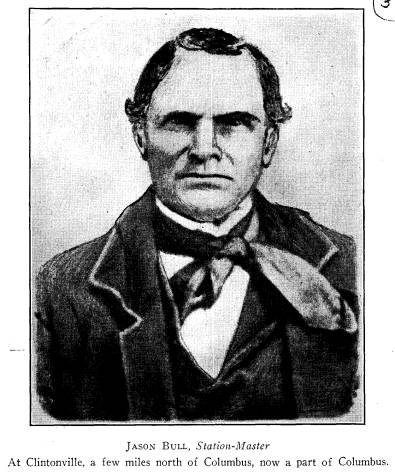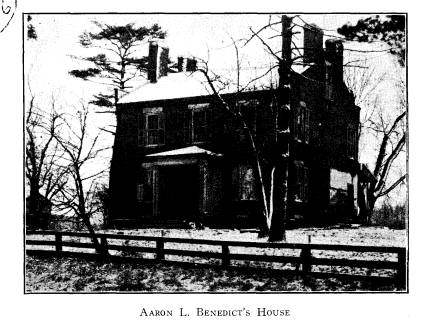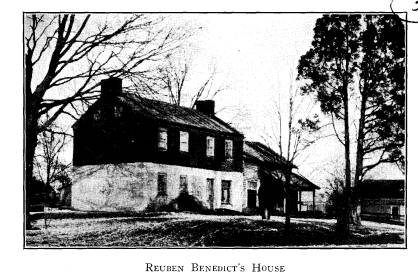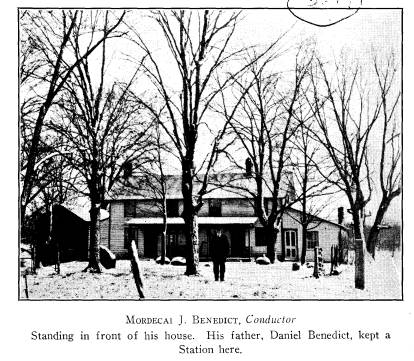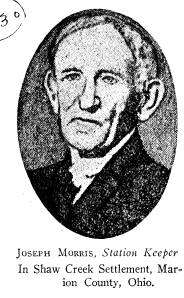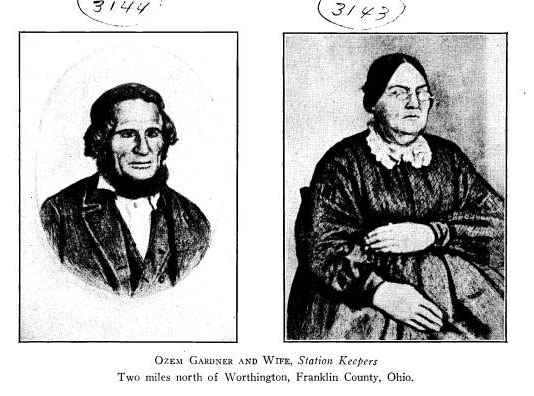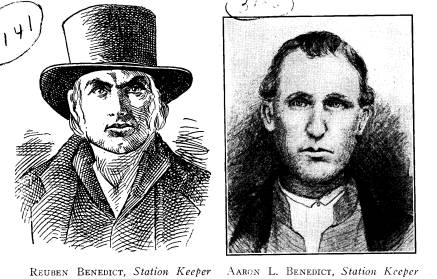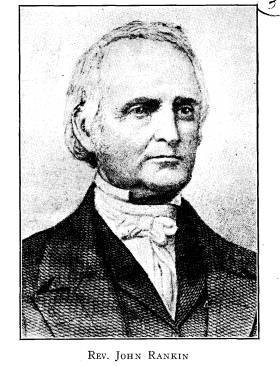Ohio History Journal
A QUAKER SECTION OF THE UNDERGROUND
RAILROAD IN NORTHERN OHIO
BY PROFESSOR WILBUR H. SIEBERT,
of the Ohio State University
One of the main lines of the
Underground Railroad
which traversed Ohio from south to
north, began at
Ripley in Brown County on the Ohio
River and ran
through Highland, Fayette, Madison,
Franklin, Dela-
ware, Marion, Morrow, and Richland
counties to Green-
wich in Huron whence branches ran to
the lake north
through Erie County and northeast
through Lorain and
Cuyahoga counties. This line of slave
travel from Ken-
tucky had, of course, its switches and
loops and at fre-
quent intervals its short-line
connections with other
more or less parallel routes to the
east and west.
Early in December, 1926, General Edward
Orton
and the writer drove to the Alum Creek
Friends' Settle-
ment, or Marengo, in Peru Township,
Morrow County,
which was for many years an important
station for har-
boring fugitive slaves on the line
roughly traced above.
General Orton had his camera with him
and acted as
the official photographer of the
"expedition," taking pic-
tures of certain houses in the
settlement where fugitives
had been secreted until they could be
sent on to neigh-
boring stations on their way to Canada
and freedom.
The first settlers on Alum Creek were
Cyrus Bene-
dict, his wife, and their three
children, who removed
(479)
|
180 Ohio Arch. and Hist. Society Publications from Peru, New York, in the autumn of 1809, to Sun- bury, Ohio. There they lived on a rented farm for a little more than a year, when they bought land and built their cabin a half-mile northeast of South Woodbury. This was early in 1811. In the autumn of the next year they were followed by the aged parents of Cyrus, namely, Aaron and Elizabeth Benedict, and several of their sons and daughters. Aaron died three years later |
|
|
|
and his wife in 1821. A married son, Reuben, settled on the west side of Alum Creek a mile south of South Woodbury and lived there until his death in 1854. Another son, Aaron, and his family also settled on the west bank of the stream and there he died at the age of fifty-six years in 1825. Of the ten children of Aaron and Elizabeth a number did not come to Alum Creek until the War of 1812 was over. When Elizabeth died at the age of eighty she left one hundred and two de- |
Underground Railroad in Northern
Ohio 481
scendants living within sixteen miles
of her, besides two
daughters and their families who had
remained in Peru,
New York. Among the children of the
second Aaron
were Aaron L. Benedict and his sister,
Esther L., who
married Griffith Levering. Aaron L. had
a son, Livius
A., who was a mere lad in the early
1850's. Another
small boy of the settlement at that
time was Mordecai
J. Benedict, who was the son of Daniel
and was born
in 1845. There was also a third Aaron
Benedict who
was born in Alum Creek settlement in
1817, grew up
to be an abolitionist, engaged in
underground railroad-
ing, and risked his life several times
in assisting fugi-
tive slaves to gain their freedom. His
father's house
in the settlement was an underground
station. He died
in 1905 at the age of eighty-eight
years.
When General Orton and the writer
visited the set-
tlement in 1926 Mordecai was the only
member of it who
had personal recollections of the
fugitive slave days. He
was then a vigorous man eighty-one
years of age, dwelling
in a neat two-story frame house in
which he had lived as
a boy. He readily recalled having seen
the floors of the
sitting-and dining-rooms covered with
the forms of
sleeping Negroes when he came
downstairs of a morn-
ing, and he named various underground
stations to the
south and north of Marengo and the
prominent op-
erators of most of them. He also
produced a family
scrapbook containing newspaper
clippings and other local
memorabilia, including a clipping that
gave an account
of a station a few miles out of Marion,
Ohio, to which
slaves were sometimes conducted from
the Alum Creek
settlement. And, finally, he loaned the
writer a pamphlet
entitled The History of Peru
Township, Morrow
Vol. XXXIX--31.
482
Ohio Arch. and Hist. Society Publications
County, Ohio, containing the "Early History of the Set-
tlement and Reminiscences by Aaron
Benedict and Oth-
ers," compiled by A. S. Benedict
and printed in 1897 by
the Sentinel Printing House of Mt.
Gilead, Ohio.
From these sources chiefly, the
following account and
incidents of the section of trunk line
of the Under-
ground Railroad extending from Columbus
to Lake
Erie have been derived.
The route through the Alum Creek
settlement had
its initial station at Ripley on the
Ohio River and led
through numerous stations to Jason
Bull's place at Clin-
tonville, thence to Ozem Gardner's two
miles north of
Worthington, and so to Joseph Eaton's,
northeast of
Delaware, on or near the southern
boundary of Morrow
County. Mr. Eaton conducted the
fugitives through
the woods to Daniel Benedict's, the
southernmost house
of the Alum Creek settlement. A little
farther to the
northeast and off the main road was
Aaron Benedict's
house. He was active in caring for the
refugees, but
his wife was a Virginian and did not
relish the idea of
assisting in the escape
of southern chattels.
Sometimes a party of the runaways would
be taken to
the home of Aaron L. Benedict on the
main road. In
1857 he built a large brick house and
there continued
to receive underground passengers, but
in case of danger
he concealed them in a barn and
out-buildings across the
creek. A half-mile west of Aaron L.
lived his brother-
in-law, Griffith Levering, who disliked
to hide the fugi-
tives. But, nevertheless, under
pressure of pursuit, they
were put in his cellar, and he wisely
kept silent. Once
the danger was past, they would be
brought back to
Aaron L.'s place. East of Marengo was
Gardner Ben-
|
Underground Railroad in Northern Ohio 483 nett's farm. He also harbored fugitives in emergen- cies, although opposed to it under ordinary circum- stances. A mile farther north on the main road lived |
|
|
|
Reuben Benedict until his death in 1854. His conscience was clear about befriending liberty-loving Negroes, and he cared for them willingly. |
|
484 Ohio Arch. and Hist. Society Publications Nine miles farther north was the Mt. Gilead Friends' settlement. The principal station keeper of that locality was Joseph Mosher, who dwelt two miles south of the county seat. If, however, there was reason to suspect that slave-hunters were lying in wait north of Marengo, the conductors from that settlement drove northeast |
|
|
|
twenty miles with their passengers to the Owl Creek Friends' settlement, which was two miles north of Fred- ericktown in Knox County. There the operators were Asa and William Townsend, Ellis Willetts, and J. E. Lewis. They forwarded the fugitives to Mansfield, where the McClures, Benjamin, James, John, Samuel, and William, and other anti-slavery residents engaged in underground activities. On the regular Alum Creek |
|
Underground Railroad in Northern Ohio 485 route there was a way station northeast of Mt. Gilead, evidently at or near Lexington in Richland County, which connected with the Mansfield center. From Mansfield the direct route ran due north to Greenwich, another Quaker settlement, in the southeastern part of Huron County. The defiers of the Fugitive Slave Law at Greenwich were Willis R. Smith and his sons, who conveyed their passengers to Milan and so to Sandusky |
|
|
|
or to Huron on the lake shore, or by a northeastern branch to Oberlin, Berea, and Cleveland. At Cleveland, Huron, and Sandusky the refugees were put on board Lake Erie vessels bound for Canada. Mordecai J. Benedict, the son of Daniel, began driv- ing fugitives by the wagon-load in 1851, when he was only six years old. Sometimes a second wagon was re- quired, the driver being in many instances Mordecai's |
|
486 Ohio Arch. and Hist. Society Publications playmate, Livius, the son of Aaron L. Benedict. The trip they usually made was to Joseph Morris's house by a branch emergency line running to the Shaw Creek Friends' settlement, about nine miles southeast of Ma- rion. In external appearance the Morris house was an unpretentious two-story frame dwelling with gable |
|
|
|
ends and a portico. It stood, and still stands, on the Canaan pike in Richland Township, and was a haven for hundreds of fugitive slaves. Its owner, a well- known Quaker philanthropist in his day, had spared no pains to make it a safe refuge for them. In the low attic and in the cellar he had built false partitions to provide |
|
Underground Railroad in Northern Ohio 487 secret chambers for his swarthy guests. A reporter of the Marion newspaper, The Press, who visited the place in October, 1900, writes that the garret was a carefully constructed labyrinth and that the cellar had two secret rooms, each capable of serving as a secure hiding-place for a dozen refugees. These rooms were hidden by large cupboards fastened to their doors. From the cel- |
|
|
lar two tunnels led out, one to the barn and the other to the corn-crib. These passages were concealed in the same manner as the secret chambers and af- forded safe egress from the house when it was surrounded by slave-hunters. It is said that in several instances Ne- groes made good their escape while their owners were on guard outside the house. Joseph Morris not only kept a rendezvous for fugitives dur- ing the anti-slavery days, but also aided escaping slaves dur- |
|
ing the Civil War. During the Virginia campaigns he was with the Union forces, giving assistance to the wounded and distressed. He rendered like service dur- ing the great fire in Chicago and became widely known for his good deeds and his charities. Tributes of appre- ciation are said to have come to him from Presidents Grant and Harrison. He celebrated his ninety-fifth birthday on June 23, 1899, and died soon after. His house was probably the safest retreat for fugitives in |
488 Ohio Arch. and Hist. Society Publications
northern Ohio. It received loads of
passengers not only
from the Marengo Friends' settlement,
but also from
the Olentangy River and doubtless more
western routes,
some of which issued from Cincinnati.
Mr. Morris for-
warded some of his numerous charges by
intermediate
stations to the Friends' settlement at
Adrian, Michigan,
whence they were carried to station
keepers at Detroit
and sent across the river to Windsor, Ontario.
It is evi-
dent from the above account that most
of the under-
ground operators on the Marengo line
and the routes
and branches with which it was
connected were Quakers.
The following incidents will show
something of the
methods of the operators of the
underground system at
Marengo and similar stations. In 1835 a
slave-owner,
on his way from West Virginia to
Missouri, camped on
the bank of the Scioto River near
Franklinton. He was
accompanied by four slaves, a mother
and her threee
children. They were abducted and hidden
away by col-
ored citizens of Columbus, who soon
conducted them to
Ozem Gardner's farm, twelve miles north
of the city.
Mr. Gardner took them to Daniel
Benedict's house at
Alum Creek settlement, where they
remained several
days. The master and two hired helpers
were able to
trace them to the settlement, found two
of the slave boys
in Daniel's yard, and started away with
them. As quar-
terly meeting was in session at
Marengo, Daniel Bene-
dict was entertaining some visiting
Quakers from Lo-
gan County. Daniel and his guests
halted the slave-
catchers at the gate and sent to the
meeting-house for
help. They also summoned Barton
Whipple, a justice
of the peace, who read the law on
kidnapping to the
slave-owner and the large group of
Friends that had
|
(489) |
|
490 Ohio Arch. and Hist. Society Publications assembled. After hearing about the heavy fine pre- scribed in the law for attempting to convey colored per- sons out of the state without proving property, the two hirelings fled through the woods. After some parley with the slave-owner, Daniel Benedict informed him that if he would leave, first promising not to molest the mother and children thereafter, the law would not be |
|
|
|
enforced against him. Accordingly, he went away. It was later reported in Marengo that one of the hirelings said that he "didn't know where all those Quakers came from, unless they came out of the ground." The next incident involves an abduction of a wife and two children from Kentucky by their slave husband and father, and a subsequent reclamation of the woman and her children by their owner. In 1837 a young col- ored man, Elisha Young by name, came to the Alum |
|
Underground Railroad in Northern Ohio 491 Creek settlement from Kentucky. His name was promptly changed to John Green. He had left in slav- ery a wife and two small children, whom he decided to rescue. Aaron Benedict hired him and promised to help him in bringing his family north. They set out with a |
|
|
|
team and carriage in the early autumn and drove to Rip- ley on the Ohio River, traveling by night for the most part. At Ripley they stopped with the Rev. John Ran- kin, one of the most noted abolitionists on the river. Mr. Rankin took Green across to the Kentucky shore in a rowboat under the cover of darkness and instructed him to burn a signal light at a certain spot on his return. |
|
|
|
(492) |
Underground Railroad in Northern
Ohio 493
The Rankin house on the hill at Ripley
was a much-
patronized station of the Underground
Railroad for
many years before the Civil War, and
was continually
receiving fugitives from across the
river, sometimes by
pre-arrangement with operators on the
other side.
About a fortnight later, Green
returned, with his fam-
ily, from a sixty-mile trip into
Kentucky, and made his
signal as agreed upon. Mr. Rankin and
Aaron Benedict
rowed across the river and brought them
back. On the
following night Mr. Benedict and his
party started
northward and in due course by night
journeys, their
days being spent with friends along the
way, arrived at
Marengo. Green and his family remained
in the settle-
ment, occupying a cabin not far from
the place of his
employer, Aaron Benedict.
About six weeks later several men
arrived in a
wagon from Delaware late at night,
entered the cabin,
took the woman and children from their
beds, and drove
off with them. Green at the time was
not at home, be-
ing in the woods with Mordecai J.
Benedict hunting for
raccoon. They were summoned by the
blowing of a
horn and emerged only in time to hear
the wagon being
driven rapidly away. It returned to
Delaware. Mor-
decai and Green soon followed on
horseback, obtained
a warrant after some delay, but failed
to find the sheriff.
At length they secured the services of
a constable near
Bellepoint on the Scioto River and
followed the kidnap-
pers to West Jefferson on the National
Road, fourteen
miles west of Columbus, where they were
found drink-
ing in a tavern. The constable would
neither serve the
warrant nor surrender it, and Mordecai
and Green could
do nothing but return home. It was no
longer safe for
494
Ohio Arch. and Hist. Society Publications
the Negro to stay at Marengo and he
soon took passage
on the Underground Railroad for Canada.
Later he
married there, having heard that his
wife had died in
Kentucky two years after her capture.
After the Civil
War Green returned and lived for a
brief time in Ash-
ley
He then went to Kentucky and brought back with
him a daughter and her husband. They
settled in Van
Wert County.
The following incident is concerned
with an exciting
rescue and the transportation of the
refugee to Canada
by the Underground Railroad. In 1838 a
Negro ran
away from his master at the Kanawha
Salt Works in
West Virginia and arrived at Marion,
Ohio, where he
became the hostler in a stable
connected with a tavern.
He was soon recognized by some one from
his old
neighborhood, who informed on him. The
master came,
had him put in jail, and returned home
to obtain wit-
nesses to prove his property. The
fugitive was kept in
prison forty days. Shortly before his
trial the sheriff's
wife, who had previously lived in or
near the Alum Creek
settlement, sent word to the Quakers of
the approach-
ing hearing. Nine of them went to
Marion, of whom
one was admitted to see the prisoner.
In the conversa-
tion between the two it was revealed
that the master
had come back, bringing six witnesses
with him and
that three of them had been owners of
the prisoner.
One was a lawyer (a Mr. Goshorn), who
had come to
assist in recovering the slave.
The Quakers conferred together and
decided to re-
sort to strategy. They also took into
their confidence a
Negro who had tried to liberate the
prisoner by under-
mining the jail. Their plan was to have
the Negro and
Underground Railroad in Northern
Ohio 495
the prisoner make a dash from the court
room as soon
as the judge had rendered his decision,
run through a
neighboring corn field, and make their
escape on fast
horses that would be in waiting for
them. The Quakers
were to block the stairway and thus
prevent pursuit.
The next day the prisoner was given his
hearing, the
witnesses testified, and bills of sale
were produced show-
ing that the slave had passed through
the hands of
several masters, being finally acquired
by John Smith,
the claimant. However, Judge Bowen
remanded the
prisoner to jail, and postponed his
decision until the
following morning. That evening one of
the Quakers
visited the prisoner and gave him full
instructions.
In giving his decision, Judge Bowen
called attention
to the fact that one of the bills of
sale designated John
Smith as the owner while the witnesses
had testified
that Mr. Smith was the owner. The judge
maintained
that these might be two different
persons and therefore
decided in favor of the prisoner.
Nevertheless, the
master seized hold of his slave,
flourished his bowie-
knife, and declared that he would have
his nigger if he
had to go to hell or Canada after him.
A rush and
scramble followed. The slave had hold
of the arm of
one of the Quakers, from which the
master could not
disengage him, while the Southerners
brandished their
pistols, knives, and clubs. Thus they
reached the street.
The sheriff called out the militia, who
succeeded in
shutting the Negro into a building,
although the door
was promptly battered in by the
attacking party. How-
ever, the fugitive and his colored
friend fled from the
rear end of the building, while the
Quakers and West
Virginians were indulging in a
scrimmage in the front.
496
Ohio Arch. and Hist. Society Publications
One of the Quakers passed through the
corn field and
awaited the coming of the two colored
men. When
they arrived they mounted the horses
provided for
them and were told where to meet their
friend. They
reached Alum Creek settlement the same
night. A few
nights later the rescued Negro was
accompanied by
Aaron L. Benedict, Griffith Levering,
and one of their
neighbors to the Owl Creek Friends
settlement, two
miles north of Fredericktown, and after
a day's rest,
they proceeded to Greenwich in Huron
County, which
was another Quaker settlement. Thence
they passed on
the next night to Oberlin, where the
refugee was placed
in safe hands. He soon landed in
Canada.
The following incident is one in which
the master
of escaped slaves and a deputy United
States marshal
were tricked into imprisoning the wrong
persons. It was
shortly after the Fugitive Slave Law
was enacted in 1850
that three Underground passengers came
to a station at
Sunbury, Ohio, late in the afternoon,
and were hidden
away. At dusk their master with a
search-warrant
and a deputy United States marshal
arrived in the
place and by chance or otherwise
questioned the keeper
of the station. He unhesitatingly
admitted that he had
seen that afternoon the three fellows
described to him,
and said that he knew a man who
secreted runaway
slaves. He suggested that the master
and the marshal
put up at the tavern and keep their
business secret until
he had tried to find the fugitives. The
slave-hunters
complied with the advice given them,
while the station
keeper made good use of the time thus
afforded him to
forward the Negroes by rapid stages. He
also decided
to play a practical joke on the
intruders by getting
Underground Railroad in Northern
Ohio 497
three of his anti-slavery friends to
blacken their faces
and hands and occupy a stable near the
jail. It was now
dark, and the station keeper went to
the tavern and
led the slavehunters to the house of a
man who, he
said, had seen three black men enter
the stable. Several
visitors were at this man's house,
presumably to see the
fun. They all went to the stable, the
supposed fugi-
tives were apprehended by the deputy marshal,
and
placed in jail, the master claiming
them as his property.
Early in the morning the deputy marshal
and gratified
owner made their appearance to get the
chattels. The
jailer kindly brought a basin of water
for them to wash
their faces and hands in, and they
emerged from their
cell white men, to the marked
discomfiture of the claim-
ant and his companion. Although the
Southerner at
once disclaimed ownership of the
released prisoners,
he was warned that he had laid himself
liable to arrest
by causing the imprisonment of these
white citizens.
The warning had the desired effect of
hastening the
departure of the master and the
marshal.
About the time of the last incident
another ruse was
practiced on two masters who, with a
warrant and a
deputy marshal had pursued their eight
slaves, men,
women and children, as far as Oberlin
and then had
passed to a place beyond where
slave-owners were ac-
customed to lie in wait for their
runaways. These
slaves had been forwarded from the Alum
Creek set-
tlement. The anti-slavery men of
Oberlin understood
the situation, and were anxious to get
the fugitives out
of danger. They therefore took eight
free negroes who
tallied pretty well with the
description of the runa-
ways, and conveyed them by wagon to the
masters'
Vol. XXXIX-32.
498
Ohio Arch. and Hist. Society Publications
waiting place. The deputy marshal
apprehended the
Negroes and put them in jail. Meantime,
the real fugi-
tives were sent by the same route to
Milan in the wagon-
bed underneath a load of hay, and so
probably to Huron.
On his return in the morning the driver
informed the
marshal that he had seen eight Negroes
depart by ves-
sel for Canada that morning.
Another instance of the outwitting of
pursuers oc-
curred near Seville in the southern
part of Medina
County, on the farm of Halsey Hurlburt,
who is de-
scribed as an abolitionist of the
Joshua R. Giddings
school. In May, 1852, a Negro, his
wife, and their
three boys were brought to Hurlburt's
house. As the
man was the property of one master and
the woman
and children, of another, they had made
their escape
and come by the Underground Railroad to
Hurlburt's.
They had spent but a single night there
when the two
masters, a deputy United States
marshal, and the
sheriff and his posse surrounded the
house and de-
manded admission. While Mr. Hurlburt
parleyed with
them his daughter Julia led the slaves
through the cellar
and by way of a corn field and piece of
woods to a
swamp near Chippewa Lake. Thence they
were able
to reach a small island and take up
their abode in a
hunter's cabin thereon. There they were
kept and fed
until all danger was past. They were
then sent in a
skiff up the lake to a place near the
Milan road, placed
in a covered wagon and carried to Milan,
where they
were put in charge of the captain of a
vessel friendly
to fugitives, sailed down the Huron
River and across
Lake Erie to the shore of Ontario. Mrs.
Hurlburt had
supplied girls' clothes for the boys
and men's garments
Underground Railroad in Northern
Ohio 499
for the women. As the steamboat was
about ready to
leave for Canada the master and an
officer came on
board, but through the shrewdness of
the captain were
unable to discover the objects of their
search. As the
vessel approached Maiden the captain
put his colored
passengers into a small boat and had
them landed on
the Canadian shore. This was a common
occurrence
in anti-slavery days, for the
underground system main-
tained its lake traffic and could
entrust its passengers to
the captains of a goodly number of the
vessels plying
on Lake Erie.
'Squire Hull skillfully threw a
slave-owner off the
scent at his farm seven miles west of
Delaware near
the Scioto River. While a slave woman
and her three
children were stopping at his house he
learned that
their master, provided with a warrant,
was looking for
them in the neighborhood. He put them
under the
floor of his barn, spread wheat in the
straw on the
floor, and set his horses to tramping
it out to prevent
the voices of the children being heard.
The master
came and searched the premises in vain.
After he had
departed the 'squire took the fugitives
to the Alum
Creek settlement. Passengers arriving at the Hull
farm
appear to have come usually from
Marysville,
which was connected with stations at
Mechanicsburg,
Urbana, Springfield, and places farther
south. 'Squire
Hull frequently drove them to the Alum
Creek settle-
ment, a distance of about twenty-five
miles. He was
afterwards president of a bank at
Bucyrus.
Some of the cruel features of slavery
are exhibited
in the following incidents. About 1850
an old colored
man and his wife were brought to Daniel
Benedict's
500
Ohio Arch. and Hist. Society Publications
house at Marengo. They had belonged to
a kind mas-
ter in Kentucky, but at his death had
been sold with
his other slaves to a trader in
Louisiana, who sold them
in turn to a sugar-planter. Their new
master was so
cruel in his treatment of them that
they fled to a cane-
brake. Bloodhounds were set on their
trail and so man-
gled the woman's limbs that she was
unable to travel
for two months. At length they made their
way back
to Kentucky, were concealed by
relatives and friends,
and conveyed by them across the Ohio
River. Thence
they traveled by the Underground
Railroad, stopped at
the Alum Creek settlement, and were
sent on their way
to Canada. On their long journey from
Louisiana to
Kentucky they experienced many
hardships, privations,
and hairbreadth escapes.
One traveler who came to the
settlement, was a
young mulatto who rode his master's
race-horses as a
jockey. In fact, he had one of the
horses with him,
on which he had escaped from
Chillicothe, where his
master was attending a race. The slave
was well
treated, except when he failed to win a
race. Then he
was severely whipped. He made up his
mind to stand
such abuse no longer and to flee the
next time they were
on Ohio soil. At Chillicothe his
master's horse won in
nearly every heat, and its owner
indulged himself in a
spree in his hotel room. The jockey
provided himself
with false whiskers cut from a black
sheepskin, put his
master to bed in a sodden condition and
donned his
clothes, took the race-horse from its
stable, and started
for Canada. With the help of
Underground station
keepers he reached the Alum Creek settlement, and
after a short stay went through safely.
Underground Railroad in Northern
Ohio 501
It has been affirmed by a former
Underground op-
erator at Marengo that Eliza and her
child, the famous
characters in Harriet Beecher Stowe's Uncle
Tom's
Cabin, came there after the young mother's thrilling
adventure in crossing the Ohio River to
Ripley on float-
ing cakes of ice with her infant in her
arms. He also
said that she undertook the hazardous
adventure in
order to avoid the pangs of separation
from her child,
which had been sold to a slave-trader by
her master,
and added that they were sent safely on
to Canada.
The number of station keepers in the
Alum Creek
settlement was six at least and
probably nine or ten.
One of these, Daniel Osborn, kept a
record of the num-
ber of fugitives received by him during
five months,
namely, from April 14 to September 10,
1844 (for the
facsimile of this record see the
writer's volume entitled
The Underground Railroad, pp. 344-345). It amounted
to forty-five. Most of these fugitives
were from Ken-
tucky, but two colored boys were from
Virginia. Un-
der date of August 16 Daniel notes that
a colored man
had gone from Gilead (probably Mt.
Gilead) back to
Kentucky and returned with his wife and
child and
his wife's sister. Eight days later he
records that a
colored woman, who had been to Canada,
returned to
the same state and brought back four of
her children
and one grandchild. The last item of
the memorandum
is dated September 10 and is to the
effect that a yellow
man from Kentucky had been caught near
Cratty's
house and carried back to slavery. It
seems likely that
during this period of five months all
the station keepers
in the Friends' settlement on Alum
Creek had cared
for not less than two hundred runaway
Negroes. The
|
502 Ohio Arch. and Hist. Society Publications writer was told on a visit to the settlement that the en- actment of the stringent Fugitive Slave Law in 1850 did not check travel on the Underground Railroad, but on the centrary increased it. For example, during a single month in the year 1854 or 1855, Aaron L. Ben- edict had as many as sixty fugitives at his house and on one occasion twenty at dinner. The statements of numerous station keepers from various northern states corroborates the above testimony as to the effect of the Fugitive Slave Act on underground passenger traffic after 1850. The slaveholders were well aware of the fact, and the widespread disregard of the provisions of the Act in the North was an important reason for their trying to withdraw from the Union. The Quaker set- tlements in Ohio certainly had their share in bringing about that situation. |
|
|
